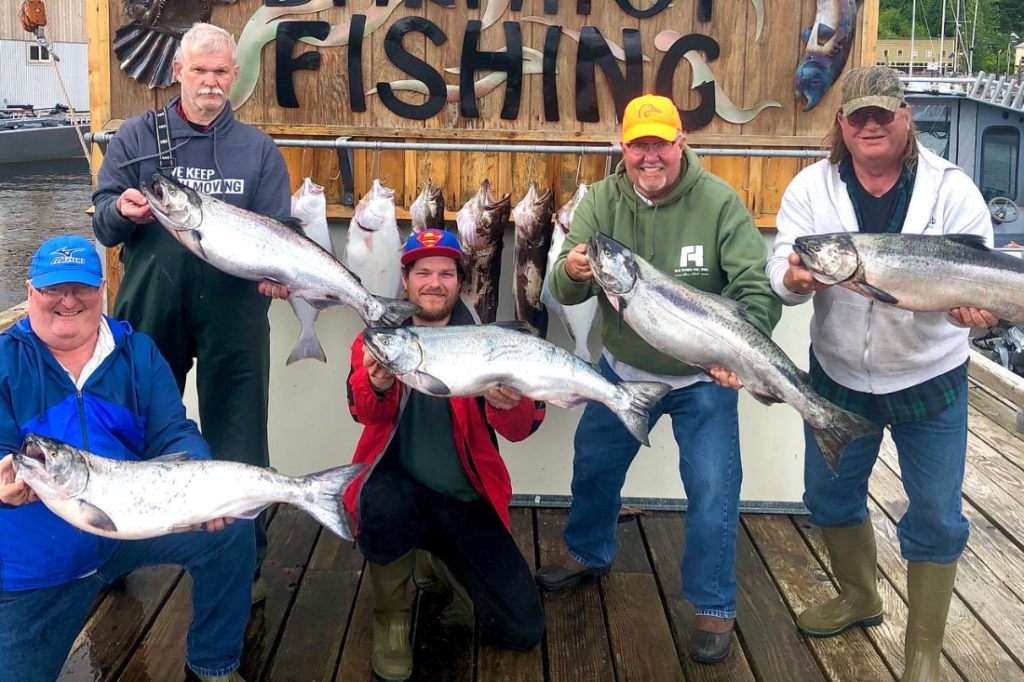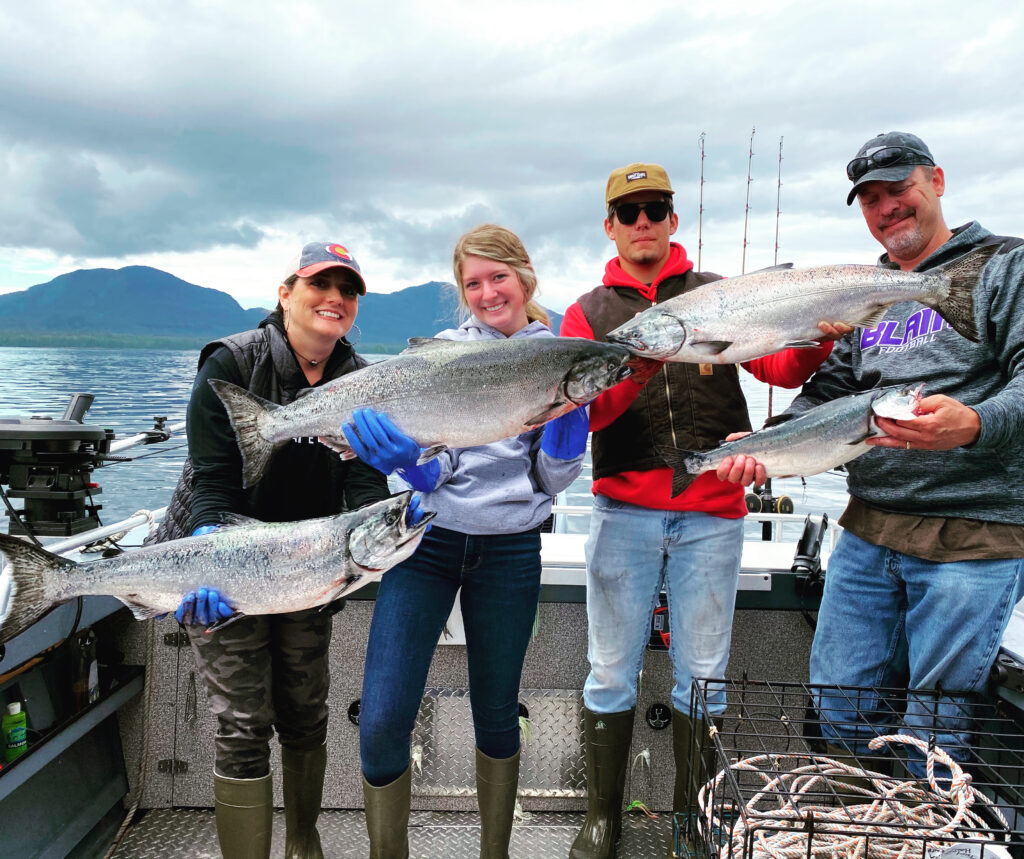Lifecycle Stages of Wild Pacific Salmon

The wild Alaska salmon lifecycle embodies the truly amazing spectacle of nature and its uniquely impressive adaptations. While salmon fishing charters in Ketchikan, Alaska offer an unparalleled opportunity to catch wild salmon, there’s also a huge education during trips on how the Alaska Salmon lifecycle effects the entire ecosystem. Ketchikan stands alone being known as , “The Salmon Capital of The World”. To this degree visitors fishing in the waters surrounding Ketchikan can become familiar with all the salmon species and their triumphant journey through life.
Identifying 5 Species Wild Pacific Salmon
To start, Alaska’s five different species of wild Pacific Salmon are one to become familiar with, by simply remembering a tried and true method. The easiest way to become acquainted with the different species of Alaska salmon is to hold up your hand and extend each of your fingers. Then by jingling off a simply rhyme it becomes distinctly illustrated which salmon species are recognized in Alaskan water and how to identify them.
Holding you thumb out we recognize the Chum salmon as thumb rhymes with chum! Then holding your index finger out and pointing to your eye, we can identify the Sockeye salmon as eye rhymes with Sockeye. While the two previous have similarly catchy rhymes we now come to the middle finger. Well the middle finger is the largest of any digit on one’s hand so what species of Salmon can we attribute this to? The might King Salmon is the largest of all of Alaska’s salmon, so it reigns supreme when correlating the largest finger with the largest salmon species. Now to the ring finger, and since there isn’t a gold salmon we move to the other colors of ring, silver. The fourth species of wild Pacific salmon is the Silver salmon. Now for the final of the five species of salmon we get to the pinky finger. Easy enough to remember as the pink y finger identifies the Pink salmon.
Salmon Fishing Species Quiz
Now that you’re equipped with knowing and understanding how to identify each species of salmon you can be confident on your Ketchikan salmon fishing excursion. While this can be slightly more complex as it relates to the multiple stages of the salmons lifecycle we’ll move into how the body transitions during each stage. Not to worry, your captain may give you a quiz on your Ketchikan salmon fishing charter, but you’re empowered with the basics for now.
Wild Alaskan Salmon Lifecycle Stages
Stage 1. Fertilized Egg
Alaska salmon begin their life in freshwater when their eggs are fertilized during the fall. Depending on which species of salmon and the temperatures of the water dictate how long the eggs incubate for in the gravel and rocks of rivers, streams and lakes. Inside the egg the salmon begins to develop eyes, a spine and tail.
Stage 2. Alevin
Once these changes have undergone and complete the egg will hatch and it transitions to the next lifecycle stage called the Alevin. Identifying this stage by an orange yolk sac attached to the body, it remains in the rocks and gravel for protection and continues to get nutrients from the yolk sac.
Stage 3. Fry
As it depletes the nutrients in the yolk sac it continues to grow until it has developed a mouth and shapes on the body. Now the salmon is ready to get mobile and start searching for food as it leaves the safety of the gravel beds. This stage is called the fry stage. During the fry stage salmon are still threatened in large part because of their lack of size and mobility. Based on this ever present danger most salmon develop parr marks. Parr marks marks run along each side of the body and act as camouflage to evade detection from predators. In this stage they begin eating food such as insect larvae and plankton in generally slower moving waters. Dependent on the species of salmon will determine how long each fry remains in freshwater. Silver salmon and sockeye salmon are known to stay in the freshwater for up to two years. King, Pink and Chum salmon generally stay for a shorter period of time, up to one year.
Stage 4. Smolt
While each characteristic of the fry stage is unique to each species of wild Pacific salmon, this development leads into the next stage of their lifecycle, the Smolt stage. Salmon fry preparing to go out to sea on their largest journey to this point lose their parr marks that acted as camouflage in the rivers and streams. Smolt vary by size dependent on species but spend sometime in the brackish water where the sea meets the mouths of freshwaters streams, rivers and lakes. Salmon grow rapidly during the smolt stage as they begin to transition into the ocean waters, preparing to embark of one of the worlds greatest open ocean migrations!
Stage 5. Adult: Open Ocean
Reaching the adult stage of life the wild Pacific salmon set out on truly wild spectacle. A phenomena rarely paralleled in the natural world for the need to grow, feed, and return to reproduce. The five different species of wild Pacific salmon will remain in the ocean feeding great distances from where they hatched in their “home streams.” The time spent in the ocean feeding depends solely on the species of salmon. These fish are referred to as “feeder” salmon and provide the highest quality of meat. Private salmon fishing charters in Ketchikan run to the richest grounds to catch all five species during this stage of their lives and as they began to return to spawn.
Stage 6. Spawning
All five species of wild Pacific salmon spend years in the open ocean feeding and the time spent in the ocean feeding depends on each species of salmon. King salmon stay in the saltwater the longest of all species, spending up to six years, feeding on herring, squid, krill, and other small bait fish. Upon returning to freshwater from the sea, salmon undergo significant physical changes. Kings, Sockeye, and Silver develop a deep red coloration, but in Southeast
Alaska spawning king salmon develop a dark brown/ blackish coloration. Chum salmon look quite vibrant when spawning as they develop multicolored calico bands resembling a tiger or zebra along each side of the body. Males of all species develop a pronounced hook in the jaw, called “kypes.” Male pink salmon and sockeye salmon develop pronounced humps on their backs. Resulting pink salmon being referred to as “humpys.”
Can you believe that after an incredible open ocean journey that each species of pacific salmon return to the stream or lake in which they were born? These returning salmon are referred to as “spawners.” Each species enters at a different time of the year, which makes it critical to know the runs and your fishing charter months to pick the best times to intercept the multiple species available. Ask your captain prior to booking a salmon fishing charter excursion. Kings enter first from May-Mid July, followed by sockeye, pinks, chums and lastly silvers. Timing of the runs vary season by season but check out the Ketchikan Salmon Fishing Article for best times for each species.
Once the salmon has reached its spawning grounds, the female and male pair up. While the female digs a bed in the gravel to deposit her eggs and the male fertilizes them. After spawning all species of wild Pacific salmon die, completing their lifecycle.
Stage 7. Post-spawn
While all wild Pacific die after they spawn its worth admiring all the the various stages of life. Evading predators from an early stage of life all the way through the final stage is quite the task to undergo. Alaskan salmon have to endure a laundry list of predators hunting them, including, Orcas, Seals, Eagles and Bears. I guess it’s why this phenomena is such an enchanting migration and lifecycle of nature. Understanding the various stages of the multiple Pacific salmon species will help ensure your best success when salmon fishing in Ketchikan. Ask your captain when booking what species are available at the different times of summer as we keep a constant pulse on each summers salmon runs.

Wild Alaskan Salmon Species
King Salmon
Alaska king salmon command a reputable size and fighting ability that’s unmatched in salmon Alaskan waters. King salmon fishing excursions in Ketchikan showcase the bright “Chrome” scales of an ocean going Chinook or king salmon, not to mention their vibrant orange meat loaded with omega-3. With their innate ability to take long drag peeling runs and acrobatic displays of jumping it’s no wonder these species of salmon garner so much attention. The best times to catch king salmon in Ketchikan are mid-May though mid-July
Pink Salmon
Pink salmon return to spawn in the freshwater streams as two-year-old fish. Making Pink salmon one of the shortest of all the species in its time spent in the open ocean feeding to making the journey back to spawn. July and August are the peak months for Salmon fishing charters in Ketchikan for clients looking to load up on Pink salmon. Easily referred to as a money fish by commercial and charter fisherman alike. When they begin to pour into the surrounding waters off Ketchikan heading to the various streams, rivers and lakes, they come in the millions. Book a salmon fishing excursions during these month to see a truly wild side of these volumous salmon runs.
Silver Salmon
Silver salmon or Coho salmon return to spawn after sixteen to eighteen months in the open ocean feeding. The best times to book a Ketchikan salmon fishing charter for Silver salmon are from mid-July through September. Easily a top rated salmon species to catch for their high quality meat and voracious feeding bites. When a good Silver salmon bite is happening it can be an all out blitz on all of your trolling lines. This species alone is favored by locals and visitors to Ketchikan for the above mention reasons.
Sockeye Salmon
While Sockeye salmon are revered for their bright red meat which gives them the nickname “Reds”, their seldom caught trolling for salmon. This is because their diet consists mainly of Krill and the lures often used to target the other species of salmon rarely mimic this presentation. With that being said the best times to catch Sockeye salmon in Ketchikan coincide with the Silver salmon runs during the months from July through September. Oftentimes when catching Silver salmon you’ll put one in the net that resembles the trademark features of a Sockeye salmon and you know you’ve added a great variety to the salmon harvest for that day.
Chum Salmon
Chum salmon or “Dog salmon” have a bright red meat but are often less desirable then the other species like king, silver, and sockeye. Although they lack the reputation for meat quality they put up an amazing fight! Testing ones tackle to withstand the brut strength these fish display when hooked while trolling for salmon. The best times to fish for Chum salmon in Ketchikan are late June through September.
